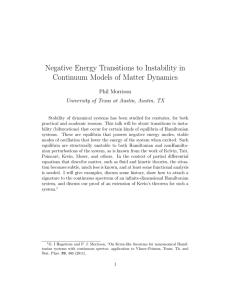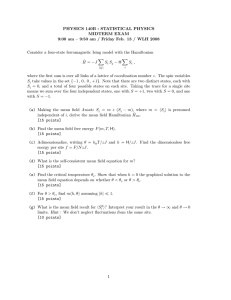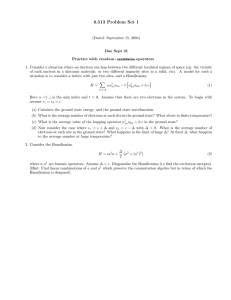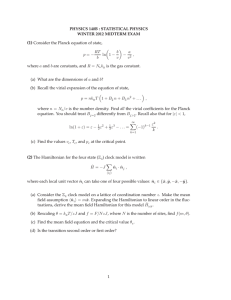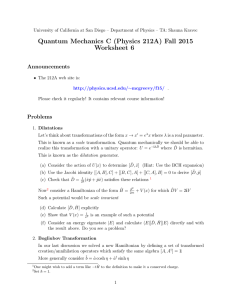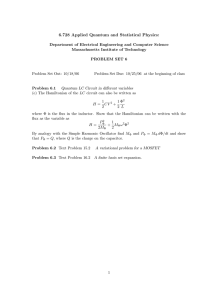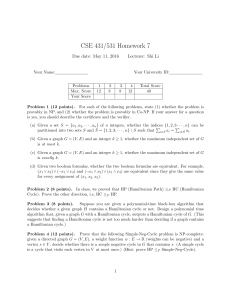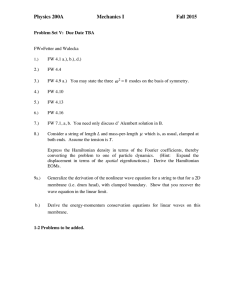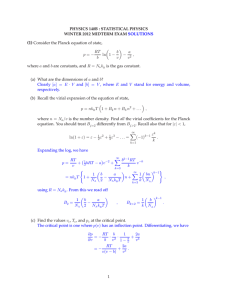Hamiltonian Description of Vlasov Dynamics: Action-Angle Variables for the Continuous Spectrum
advertisement
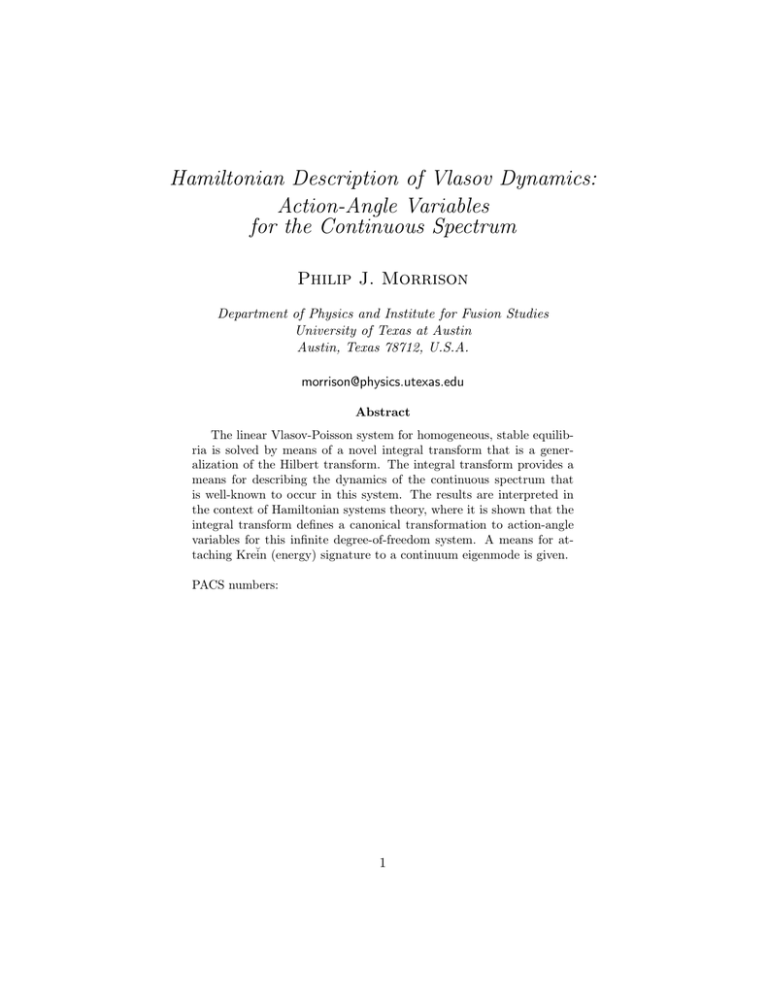
Hamiltonian Description of Vlasov Dynamics:
Action-Angle Variables
for the Continuous Spectrum
Philip J. Morrison
Department of Physics and Institute for Fusion Studies
University of Texas at Austin
Austin, Texas 78712, U.S.A.
morrison@physics.utexas.edu
Abstract
The linear Vlasov-Poisson system for homogeneous, stable equilibria is solved by means of a novel integral transform that is a generalization of the Hilbert transform. The integral transform provides a
means for describing the dynamics of the continuous spectrum that
is well-known to occur in this system. The results are interpreted in
the context of Hamiltonian systems theory, where it is shown that the
integral transform defines a canonical transformation to action-angle
variables for this infinite degree-of-freedom system. A means for attaching Kreĭn (energy) signature to a continuum eigenmode is given.
PACS numbers:
1
1
1.1
Introduction
Motivation and overview
There are two main points of this paper: (1) to describe an integral transform
for solving the Vlasov-Poisson equation linearized about a homogeneous,
stable equilibrium and (2) to interpret this transform method of solution in
the context of infinite degree-of-freedom Hamiltonian dynamics.
In Sec. 2 we describe the integral transform, a generalization of the
Hilbert transform, that is specifically designed to unravel the continuous
spectrum, which is well-known to occur in the linearized Vlasov-Poisson
system. This transform was introduced elsewhere (Refs. [1] and [2]), but
the level of rigor given here is much higher. If a method provides a rigorous
solution, then one may question the necessity of the Hamiltonian formalism,
which we present in Sec. 3. We address this question below by describing a
sort of Hamiltonian philosophy.
In the past couple of hundred years a sizable body of lore has accumulated about finite degree-of-freedom Hamiltonian systems, and indeed
remarkable progress has been made in the past 50 years. For example, it
is now recognized that systems with one degree of freedom are integrable
and that such systems are exceptional. It is known that systems with two
degrees of freedom are generically nonintegrable, invariant tori are broken,
and ‘chaos’ is the norm. In systems with three or more degrees of freedom
invariant tori no longer separate phase space, and thus no longer provide
barriers to transport. The philosophy in which one uses results and procedures from finite systems as a guide for investigation of infinite systems is
one to which we subscribe. Relatively speaking, not nearly so much is known
about infinite systems. Although all phenomena of finite systems occur in
infinite systems, there are new phenomena that can occur only in infinite
systems. One example of this is the continuous spectrum, and interpreting
this in the Hamiltonian context is one of our main points.
Perhaps the most compelling argument for the Hamiltonian point of
view resides in its generality. The most important equations of physics are
Hamiltonian, and when one solves one problem one solves a whole class
of important problems. For example, it has been proven that all stable
finite degree-of-freedom Hamiltonian systems can be transformed so that
2
the Hamiltonian obtains the following normal form:
H=
N
N
N
ωa 2
pa + qa2 = −i
ωa Qa Pa =
ωa Ja
2
a=1
a=1
(1)
a=1
which we have written three ways. The first way demonstrates that the
dynamics is merely that of a collection of uncoupled oscillators or normal
modes, while the last way corresponds to the action-angle variable description in which the angle variable is ignorable. The middle way is sometimes
convenient because it incorporates the complex eigenvectors as coordinates;
we record it for later use.
So, is there a similar normal form for infinite degree-of-freedom Hamiltonian systems with a continuous spectrum? The answer to this question
is yes, and as one might expect the normal form is given by something like
the following:
H=
ω(u) J(u) du .
(2)
In Sec. 3 we demonstrate this for the Vlasov-Poisson system, but it is also
true for the Vlasov-Maxwell system (Ref. [3]), the two-dimensional Euler
fluid equations (Ref. [5]), and others. It is now clear that something general
is going on: the continuous spectrum is resolved by a class of transformations
that is a generalization of the Hilbert transform.
A feature of the normal form (1) that carries over to infinite dimensions
is the notion of signature. The first form of (1) is a quadratic form, which
need not be positive definite: in general the frequencies satisfy ωa = σa |ωa |
with σa ∈ {−1, 1}. Even though some of the oscillators may have negative
frequencies, they are still stable oscillators. For the obvious reason they
are called negative energy modes. It is known by Sylvester’s theorem that
the signature, defined to be the difference between the number of positive
and negative modes, is invariant under real similarity transformations, and
so to the extent that energy is defined, signature has physical meaning.
Perhaps the most important role of signature is the one it plays in governing
bifurcations. A theorem of Kreĭn [independently proved by Moser (see.e.g.
Refs. [4])] states that a necessary condition for the bifurcation from stability
to instability is that colliding modes possess opposite sign. At the end of
Sec. 3 we discuss signature in the context of the continuous spectrum of the
Vlasov-Poisson system.
We conclude the present section by describing the Vlasov-Poisson system
and collecting together some notions that will be used in the remainder of
the paper.
3
1.2
The Vlasov-Poisson system
The one-dimensional Vlasov-Poisson system has a single dynamical variable,
the phase space density f (x, v, t), and can be thought of as a 1 + 1 + 1 field
theory; i.e. a theory with one space, one velocity (or momentum), and one
time variable. We have f : X × IR2 → IR, where X is the spatial part and
typically X is either S 1 or IR. In the former case we have periodic boundary
conditions while in the latter case we have a some kind of decay condition
at infinity. Physical initial conditions satisfy f (x, v, 0) ≥ 0.
The Vlasov-Poisson system is composed of the equation for the conservation of phase space density,
∂f
∂f
e ∂φ[x, t; f ] ∂f
+v
−
=0
∂t
∂x m
∂x
∂v
(3)
and Poisson’s equation,
φxx = −4π e
IR
f (x, v, t) dv + ρB ,
(4)
where ρB is a background charge density that is chosen so that the total
charge vanishes. Equations (3) and (4) formally conserve the following energy functional:
H=
m
2
v 2 f dx dv +
X
IR
1
8π
X
(φx )2 dx ,
(5)
which is composed of the sum of kinetic energy plus electrostatic energy
pieces. This energy is actually the Hamiltonian for the infinite degree-offreedom Hamiltonian description that we consider in Sec. 3.
In this work we are interested in perhaps the simplest plasma problem,
that of linearization about a homogeneous, stable equilibrium. Thus we set
f = f0 (v) + δf (x, v, t), insert this in (3) and (4), and obtain
∂δf
∂δf
e ∂δφ[x, t; δf ] ∂f0
+v
−
=0
∂t
∂x
m
∂x
∂v
and
δφxx = −4πe
(6)
δf (x, v, t) dv .
(7)
IR
This linear system formally conserves the following energy functional:
HL [δf ] = −
m
2
X
IR
v
1
(δf )2 dx dv +
f0
8π
4
X
(δφx )2 dx
(8)
which will be seen in Sec. 3 to be the Hamiltonian for this system.
It is well-known that the solution◦ to the full Vlasov-Poisson system can
be written as a rearrangement: f = f ◦Z, where Z represents the solution to
the characteristic equations run◦ backwards in time. Equivalently, this can
◦
◦
be written out as f (x, v, t) = f (x(x, v, t), v(x, v, t)). It is also well-known
that not all rearrangements are allowed: only those that preserve the area
measure dxdv. Thus it is natural to restrict initial perturbations to be
rearrangements of the equilibrium state. In Refs. [6] and [1] we called such
restricted variations dynamically accessible variations and obtained for the
linear dynamics, which takes place on the tangent space to the space of such
rearrangements, the following formula for them:
δf = [h, f ] ,
where
[A, B] :=
1
m
(9)
∂A ∂B ∂B ∂A
−
∂x ∂v
∂x ∂v
(10)
is the usual Poisson bracket, f is any phase space density, and h is an
arbitrary (sufficiently well-behaved) phase space function. Of interest here
are variations about a homogeneous
equilibrium state that are to be initial
◦
conditions for (6). Thus we have δ f = [h, f0 ] = hx f0 /m where f0 := ∂f0 /∂v.
◦
This implies, for reasonable h’s, that δ f has the same extrema as f0 . Also,
it is easy to show that if a function is initially of the form of (9), then under
the dynamics of (6) it will be so for all time; i.e. δf at any time can be
written in the form of [h, f0 ] for some function h.
In closing this section we point out that the idea of dynamical accessibility has recurred many times in the literature in different contexts, many
of which are pointed out in Ref. [7], which along with Refs. [6], [1], and [8]
is a source of more detailed information.
2
Linear Vlasov solution by integral transform
Now consider the integral transform solution. Because the continuous spectrum, our main object of concern, is associated with velocity dependence,
we remove the spatial dependence by Fourier decomposition,
δf =
fk (v, t)eikx ,
δφ =
k
k
5
φk (t)eikx
(11)
and write the linearized Vlasov-Poisson system as
∂fk
e
+ ikvfk − ik φk f0 = 0
∂t
m
k 2 φk = 4πe
IR
fk (v, t) dv .
(12)
These are the equations we solve. Henceforth, k enters as a parameter and
we will not be concerned with the reconstruction of the x-dependence. We
assume k does not vanish, but otherwise it can take on any real value. Note,
the assumption k = 0 is consistent with dynamical accessibility, because
hx ∼ ikhk . Hence, a dynamically accessible initial condition vanishes for
k = 0 and the k = 0 term in the Fourier series for δf will remain zero for
all time.
Equations (12) have been well-studied by essentially two methods: the
Laplace transform method that originates with with Landau in 1946 and
the normal mode approach that originates with Van Kampen in 1955. Since
these original papers there have been many works of varying degrees of rigor
and generality. (See e.g. Refs. [9], [10], and [11].) The integral transform
method treated here, which originates in Refs. [1] and [2], amounts to a
coordinate change that makes the time integration trivial. This method is
closest to Van Kampen’s approach, but the spirit is very Hamiltonian, an
interpretation that is deferred to Sec. 3.
The integral transform method is very simple once the transform is
known and understood. We introdue the G-transform [given by Eq. (15)],
that transforms (12) into
which we prove has an inverse G
∂gk
(13)
+ iku gk = 0 .
∂t
◦
◦
The solution to (13) is obviously gk (u, t) = gk exp(−ikut), where gk (u) :=
◦
◦
◦
f ], where f (v) := fk (v, t = 0), we obtain the
gk (u, t = 0). Using gk = G[
k
k
solution upon transforming back with the G-transform:
fk (v, t) = G[gk (u, t)]
◦
◦
f ]e−ikut .
= G gk (u)e−ikut = G G[
k
(14)
In the remainder of this section we make this rigorous. In 2.1 we describe
classes of equilibria and initial conditions that our solution method accommodates, and we remark on their physical significance. In 2.2 we review
some properties of the Hilbert transform, which we use in 2.3 to prove the
main theorems about the G-transform. Lastly in 2.4 we state precisely the
nature of the solution.
6
2.1
Equilibria and initial conditions
Definition (VP1) A function f0 (v) is a good equilibrium if f0 (v) satisfies
(i) f0 ∈ Lq (IR) ∩ C 0,α (IR) for some q such that 1 < q < ∞ and some α
such that 1 < α < ∞ ,
(ii) ∃ v∗ > 0 such that |f0 (v)| < A|v|−µ , ∀ |v| > v∗, where A > 0 and
µ > 0 , and
(iii) f0 /v < 0 , ∀ v ∈ IR , or f0 satisfies the Penrose criterion described
below. (We assume f0 (0) = 0.)
Remarks:
1. C 0,α is the space of Hölder functions that satisfy |f (x)−f (y)| < K|x−
y|α , where 0 < α ≤ 1. For our purposes local Hölder is sufficient and
we exclude the case α = 1 (Lipschitz).
2. Because (12) only depends on f0 , conditions on f0 are sufficient for
determining properties of its solutions. However, the physics
requires
other conditions, such as, f0 (v) ≥ 0 and that the integrals IR v n f0 dv,
for n = 0, 1, 2, exist in some sense.
3. Item (iii) assures that the spectrum is entirely continuous, i.e. does
not possess a discrete component. The Penrose criterion relaxes the
monotonicity condition and allows for negative energy modes, which
were mentioned in Sec. 1 and are described in Sec. 3.
4. Maxwellian equilibria are included in our class of good equilibria, along
with bump on tail equilibria with sufficiently small and slow bumps,
and other interesting equilibria as well. However, we are excluding cold
beams that are distributions, f0 ∼ δ(v − v0 ), and waterbag equilibria
and others of compact support. The solution method is more powerful
than what is stated here and can be generalized to e.g. piecewise Hölder
functions, and probably functions of bounded mean oscillation.
◦
Definition (VP2) A function, f k (v), is a good initial condition if it sat◦
◦
isfies f k , v f k ∈ Lp (IR) .
7
Remarks:
1. The above requirements assure that all the terms of (12) exist at the
initial time. It follows that the initial charge and corresponding potential also exist.
◦
2. The physics suggests IR v n f k (v) dv < ∞, for n = 1, 2, i.e. in addition
to the charge, momentum and energy-like integrals should
exist in
◦
some sense. These should even exist locally. Likewise IR v |f k | 2 /f0 dv
should exist, because this is part of HL , the Hamiltonian functional.
2.2
Hilbert transform review
The Hilbert transform is defined by
H[g](x) :=
P
π
IR
g(y)
dy ,
y−x
where P denotes the Cauchy principal value. There are many theorems
about Hilbert transforms in the spaces Lp and C 0,α . (See e.g. Ref. [12].) We
state some of them without proof.
Theorem (H1)
(ii) H: Lp (IR) → Lp (IR), for 1 < p < ∞, is a bounded linear operator:
H[g]p ≤ Ap gp ,
where Ap depends only on p,
(ii) H has an inverse on Lp (IR), given by
H[H[g]] = −g ,
and
(iii) H: Lp (IR) ∩ C 0,α (IR) → Lp (IR) ∩ C 0,α (IR).
The proof of (H1) is given in the classical works of Plemelj, M. Riesz,
Zygmund, Titchmarsh and others. (See e.g. [13] and [14].) It can also be
extracted from the more general Calderón-Zygmund theory. (See e.g. [15]
and [16].)
8
Theorem (H2) If g1 ∈ Lp (IR) and g2 ∈ Lq (IR) with
1 < p, q < ∞, then
1
p
+
1
q
< 1 where
H[g1 H[g2 ] + g2 H[g1 ]] = H[g1 ]H[g2 ] − g1 g2 .
A proof based on the Hardy-Poincaré-Bertrand theorem was given by
Tricomi and can be found in [17].
Lemma (H3) If g, vg ∈ Lp (IR), then
H[vg](u) = u H[g](u) +
1
π
g dv .
IR
Proof : Because g, vg ∈ Lp (IR) ⇒ g ∈ L1 (IR), we can use
v
u+v−u
u
=
=
+1
v−u
v−u
v−u
to split the integral H[vg] into the two terms, which individually exist. ✷
2.3
The G-transform
Definition (G1) The G-transform is given by
f (v)
= G[g](v)
:= ,R (v) g(v) + ,I (v) H[g](v) ,
where
,I (v) = −π
ωp2 f (v) ,
k2 0
(15)
,R (v) = 1 + H[,I ](v) .
Remarks:
1. In the remainder of this section we suppress the dependence of , and
other quantities upon k. Note, ωp2 := 4πn0 e2 /m is the plasma frequency corresponding to an equilibrium of number density n0 .
9
2. The quantity , = ,R + i,I (when extended into the complex v-plane) is
the plasma dispersion relation whose vanishing implies the existence
of discrete normal eigenmodes. When , does not vanish, the system
has only a continuous component to the spectrum.
To prove boundedness of the G-transform we will need the following
Lemma (G2) If ,I ∝ f0 ∈ Lq (IR) ∩ C 0,α (IR), then ,R , ,I ∈ L∞ (IR).
Proof : Because the Hilbert transform preserves C 0,α and ,R − 1 = H[,I ],
both ,R and ,I are continuous. The Lemma follows from lim|v|→∞ ,I = 0 and
lim|v|→∞ ,R = 1, where the latter is easily demonstrated for good equilibria.
✷
Theorem (G3) G: Lp (IR) → Lp (IR), 1 < p < ∞, is a bounded linear
operator:
G[g]p ≤ Bp gp ,
where Bp depends only on p.
Proof : Because ,I and ,R are Hölder and by Lemma (G2) bounded, g ∈
Lp (IR), H[g] ∈ Lp (IR) and thus G[g] ∈ Lp (IR). By the triangle inequality,
Hölder’s inequality, and the boundedness of H[g],
G[g]p ≤ ,R gp + ,I H[g]p
≤ ,R ∞ gp + ,I ∞ H[g]p
≤ Bp gp .
✷
Theorem (G4) If f0 is a good equilibrium, then G[g] has a bounded inverse,
Lp (IR) → Lp (IR) ,
G:
for 1/p + 1/q < 1, given by
g(u)
](u)
= G[f
,R (u)
,I (u)
:=
f (u) −
H[f ](u) .
2
|,(u)|
|,(u)|2
where |,|2 := ,2R + ,2I .
Proof : First we show g ∈ Lp (IR) and then g = G[G[g]].
10
If ,R (u)/|,(u)|2 and ,I (u)/|,(u)|2 are bounded, then clearly g ∈ Lp (IR).
For good equilibria the numerators are bounded and everything is Hölder,
so it is only necessary to show that |,| is bounded away from zero. Either
of the conditions of (VP1)(iii) assures this:
If the first condition is satisfied then |f0 | > 0 for v = 0 and f0 (0) = 0.
Therefore we need only look at v = 0 and v = ∞ to assure |,| = 0. At v = 0
ω2
,R (0) = 1 − P2
k
IR
f0
dv > 1 > 0 ,
v
while as v → ∞, ,R → 1.
The second condition, the Penrose criterion (see e.g. [10]), uses the argument principle of complex analysis to show |,| = 0. It states that there
are no discrete modes if for all minima, vm , of f0
IR
or better if
f0 (v) − f0 (vm )
dv < 0 ,
(v − vm )2
f0 (v)
dv < 0 .
IR v − vm
Note this criterion is independent of k, but allows inversion of the Gtransform ∀ k.
is the inverse follows directly upon inserting G[g] of (G1) into
That G
g = G[G[g]],
and using (H2) and ,R (v) = 1 + H[,I ]. We write out the steps:
,R
,I
f − 2 H[f ]
2
|,|
|,|
,R ,I
,
g
+
,
H[g]
−
H
,
g
+
,
H[g]
R
I
R
I
|,|2
|,|2
,2R
,R ,I
,I
,I g
+
H[g]
−
H[g]
−
H
H[,
]
g
+
,
H[g]
I
I
|,|2
|,|2
|,|2
|,|2
,2R
,R ,I
,I
,I g
+
H[g]
−
H[g]
−
H[,
]H[g]
−
g
,
I
I
|,|2
|,|2
|,|2
|,|2
,R ,I
,I
,I
g+
H[g] − 2 H[g] − 2 H[,I ]H[g]
|,|2
|,|
|,|
,R ,I
,I
g+
H[g]
−
H[g]
1
+
H[,
]
I
|,|2
|,|2
,R ,I
,I
g+
H[g] − 2 H[g],R = g
2
|,|
|,|
]=
g = G[f
=
=
=
=
=
=
11
✷
Lemma (G5) If ,I and ,R are as above, then
(i) for f, vf ∈ Lp (IR),
](u) −
G[vf
](u) = u G[f
I ](u) =
(ii) G[,
I 1
||2 π
IR
f dv ,
I (u)
||2 (u)
(iii) and if f (u, t) and g(v, t) are strongly differentiable in t; i.e. the mapping t → f (t) = f (t, ·) ∈ Lp (IR) is differentiable with the usual difference quotient converging in the Lp sense, then
a) G
b) G
∂f
∂t
∂g
∂t
=
]
∂ G[f
∂t
=
∂g
∂t
=
∂G[g]
∂t
=
∂f
∂t
,
.
Proof : (i) goes through like (H3), (ii) follows from ,R = 1 + H[,I ], and (iii)
follows because G is bounded and linear.
✷
2.4
The solution
Now we are in a position to justify the solution (14) that was described at
the beginning of this section.
Theorem (S1) For good initial conditions and equilibria,
◦
f ]e−ikut
fk (v, t) = G G[
k
is a solution of (12) in the strong Lp sense [cf. Lemma (G5)].
Proof : The only thing left to show is that the time derivative of the expression for fk (v, t) is in fact in Lp . Since differentiation pulls down a factor of
◦
f ] ∈ Lp , which in turn follows from the first item
u, the result follows if uG[
k
of Lemma (G5) for good equilibria and initial conditions.
✷
Remarks:
1. The solution above can be compared to that for a sum over eigenvectors, Gj : z i (t) = aj Gij ei ωj t , which when projected onto an initial
◦
◦
◦
condition z gives aj = (Gkj )−1 z k . Whence z i (t) = Gij (Gkj )−1 z k ei ωj t .
12
2. The analogue of Gi is the Van Kampen singular eigenfunction
G(u, v) = ,I (v)
P 1
+ ,R (v) δ(v − u) ,
π u−v
which is the eigenfunction for the continuous spectrum, indexed by
u ∈ IR.
3
Hamiltonian Description
Now we interpret the results of Sec. 2 in the Hamiltonian context. In 3.1
we briefly review the generalization of Hamiltonian theory that is possessed
by the equations that describe the dynamics of classical media in terms of
Eulerian variables. In 3.2 we do two main things: we change variables so
that the Hamiltonian description of (20) achieves canonical form in terms
of canonically conjugate variables, (qk , pk ), and then we use the results of
Sec. 2 to construct a canonical transformation to new canonical variables,
(Qk , Pk ), in terms of which the Hamiltonian HL achieves diagonal form. This
latter form is essentially action-angle form, which we describe. The section
is concluded with a brief discussion of signature and Kreĭn’s theorem.
3.1
Hamiltonian structure for Vlasov-Poisson
There is a standard and general Hamiltonian structure possessed by physical
systems that describe media in terms of Eulerian variables. For example,
ideal fluid equations, including magnetohydrodynamics, and various kinetic
theories, including the Vlasov-Poisson equations, possess this structure. (See
Ref. [7] and many references therein.) It is a structure that dates back to
the nineteenth century and the work of Sophus Lie, but its importance for
describing fluid and plasma equations was not realized in generality until
around 1980. Since then a great deal of research, much of it with a definite
modern geometric flavor, has been done.
Ordinarily Hamilton’s equations are written as follows:
q̇ a =
∂H
,
∂pa
ṗa = −
∂H
,
∂q a
(16)
where a = 1, 2, ..., N . However, if these equations are written in terms of
arbitrary noncanonical variables or coordinates, z = (q, p), they obtain the
form
∂H
ż µ = J µν ν = [z µ , H] ,
(17)
∂z
13
where µ = 1, 2, ..., 2N , and the Poisson bracket becomes
[A, B] :=
∂B
∂A µν
J (z) ν .
∂z µ
∂z
The essence of being Hamiltonian lies in the fact that [A, B] is a Lie bracket,
i.e. it is bilinear and satisfies
[A, B] = −[B, A]
and
[A, [B, C]] + [B, [C, A]] + [C, [A, B]] = 0 ,
for all functions A, B and C. The latter condition, known as the Jacobi
identity, is the crux of the matter: by a nineteenth century result credited
to Darboux, if det J = 0, then at least locally there exists a canonical set of
coordinates in which Eqs. (17) have the form of (16). Also, in the nineteenth
century Sophus Lie studied the case where det J = 0 and concluded that
a system of coordinates exist in which Eqs. 17 have the form of a smaller
canonical system plus some coordinates, called Casimir invariants, that are
constants of motion.
Lie studied the bracket
γ
J µν = cµν
γ z
⇐⇒
γ
[A, B] = cµν
γ z
∂A ∂B
,
∂z µ ∂z ν
where cµν
γ are the structure constants (or operators) of some Lie algebra.
But it was unbeknownst to Lie that this kind of Poisson bracket, now called
a noncanonical Poisson bracket of Lie-Poisson type, describes continuous
media. The quantity J, called the Poisson tensor or cosymplectic form, is
linear in the dynamical variables, unlike that for conventional (canonical)
field theories such as the Klein-Gordon equation.
It is apparent that the Vlasov-Poisson system cannot possess canonical
form. Its energy, as given by (5), is quadratic in f and such Hamiltonians
give rise to linear theories like the simple harmonic oscillator or the wave
equation. Also, f is the only dynamical variable, and so a conjugate is
missing. A simple dimensional analysis reveals that if this system is to be
noncanonically Hamiltonian, then the Poisson bracket must be linear in f .
The Vlasov-Poisson system possesses an infinite-dimensional generalization
of the structure studied by Lie. The table shows the correspondence between
quantities in a finite-dimensional theory and those for the Vlasov-Poisson
14
system.
F inite
←→
VP
z
←→
f
µ
←→
(x, v)
A(z)
←→
F [f ]
δA = ∇A · δz
←→
γ
J µν = cµν
γ z
←→
δF
δf dx dv
X IR δf
J = −[f, · ]
δF =
The first row compares dynamical variables; the second, indices, with µ
being discrete and (x, v) ∈ X × IR; the third, phase space funtion(als); the
fourth compares first variations and serves to define the functional derivative
δF/δf , which is evidently an infinite-dimensional gradient; and the last row
compares cosymplectic forms.
The noncanonical Hamiltonian description for the Vlasov-Poisson system
was first given in [18]. The Poisson bracket, with the cosymplectic form of
the table, is the following:
{F, G} =
δF δG
f
dx dv ,
,
δf δf
IR
X
(18)
where F and G are functionals of f . In terms of (18) the Vlasov-Poisson
system can be written as
∂f
= {f, H} = [E, f ].
∂t
where H is the energy functional of (5), E = mv 2 /2+eφ, and [E, f ] is defined
by (10).
Letting f = f0 (v) + δf , as in Sec. 1.2, and linearizing gives
{F, G}L =
X
IR
f0
δF δG
,
δδf δδf
dx dv ,
(19)
where F and G are now functionals of δf and δF/δδf is an unfortunate
notation for the functional derivative of F with respect to δf . With the
Hamiltonian (energy) of (8), (19) gives the linearized Vlasov-Poisson equations in the noncanonical Hamiltonian form
∂δf
= {δf, HL }L .
∂t
15
(20)
3.2
Canonization and diagonalization
Upon expanding δf in a Fourier series as in (11), the Poisson bracket (19)
can be written as
{F, G}L =
∞
ik
k=1
m
IR
f0
δF δG
δG δF
−
δfk δf−k
δfk δf−k
dv ,
(21)
and the Hamiltonian (8) becomes
HL = −
=
v
m 1 2
|fk |2 dv +
k |φk |2
2 k IR f0
8π k
k,k IR IR
fk (v) Ok,k (v|v ) fk (v ) dv dv ,
(22)
where
Ok,k (v|v ) := −
m v
2πe2
δ(v − v ) +
δ
fk (v)fk (v ) δk,−k ,
k,−k
2 f0
k2
(23)
with δk,−k and δ(v − v ) being the Kronecker and Dirac delta functions,
respectively. Because of the second term of (23) the Hamiltonian (22) is not
diagonal; i.e. it is not in a form that is an infinite dimensional generalization
of (1).
In terms of (21) and (22), (12) can be written in noncanonical Hamiltonian form as
∂fk
(24)
= {fk , HL }L ,
∂t
which is merely the projection of (20) onto Fourier modes.
This description can now be canonized, i.e. written in terms of canonical
variables, by the simple scaling transformation,
qk (v, t) = fk (v, t) ,
which gives
{F, G}L =
pk (v, t) =
∞ δF δG
k=1 IR
m
f−k (v, t) ,
ikf0
δG δF
−
δqk δpk
δqk δpk
dv .
Note that a possible singularity occurs in this transformation at points where
k = 0 or f0 = 0; however, both of these are ruled out by restricting initial
conditions to be dynamically accessible.
16
Diagonalization is achieved using the following mixed variable generating
functional to generate a canonical transformation from (q, p) to (Q, P ) :
F[q, P ] =
∞ k=1 IR
k ](v) dv .
Pk (v) G[q
(25)
As is usual for generating functions of this type, the transformation is given
by
pk (v) =
δF[q, P ]
† [Pk ](v) ,
=G
δqk (v)
Qk (u) =
δF[q, P ]
k ](u) .
= G[q
δPk (u)
(26)
The new Hamiltonian in terms of these variables takes the form
HL = −
∞ i ωk (u) Qk (u) Pk (u) du ,
k=1 IR
(27)
where ωk (u) = ku. Thus we have transformed to an infinite-dimensional
generalization of the normal form of (1). This is diagonalization.
Above we have introduced complex variables in our transformations.
However, ultimately the dynamical variables of Vlasov theory correspond
to real physical quantities and are thus real variables. Everything we have
done could have been done entirely in terms of real variables. This would
have been awkward, but, as for finite degree-of-freedom systems, it has the
advantage of keeping track of the invariant signature of the Hamiltonian.
The signature can be recovered by the following transformation to actionangle variables, (Jk , θk ),
Jk (u, t) eiσk θk (u,t) ,
Qk (u, t) =
Pk (u, t) = i Jk (u, t) e−iσk θk (u,t) ,
(28)
where the signature is given by σk (u) := sgn(ku,I ). In terms of these variables the Hamiltonian becomes
HL =
∞ k=1 IR
σk (u) ωk (u)Jk (u, t) du ,
(29)
where ωk (u) := |ku|, and the Poisson bracket becomes
{F, G}L =
∞ δF δG
k=1 IR
δG δF
−
δθk δJk
δθk δJk
17
du .
(30)
Thus we have achieved the normal form of (2).
The quantity σk (u) assigns a signature to a continuum eigenmode, analogous to that for finite systems. In the study of finite systems, one assumes
the Hamiltonian depends upon a parameter and then investigates bifurcations as this parameter is varied. As mentioned above, when discrete
eigenmodes collide Kreĭn’s theorem states that a necessary condition for
the bifurcation to instability is that the colliding modes have opposite signature. The Penrose criterion can be used to analyze bifurcations in the
Vlasov-Poisson system, and indeed it can be shown that unstable modes
emerge from the continuum at places where positive and negative continuum eigenmodes meet, a result that suggests an infinite dimensional version
of Kreĭn’s theorem. However, unlike the finite case, care must be taken in
defining the ‘distance’ from the bifurcation point. Because any point of the
continuum is point-wise arbitrarily close to either signature, a Sobolev type
norm is required. A general discussion of Kreĭn’s theorem for infinite dimensions will be given in future work, along with several items described in
the next section.
4
Summary and future work
In this paper we described an integral transform, or equivalently a coordinate change, that enabled us to obtain an Lp solution of the Vlasov-Poisson
system linearized about good equilibria with good initial conditions. The
equilibria considered possess a continuous spectrum with no discrete component. The Hamiltonian transformation to action-angle variables was given.
Signature for the continuous spectrum was defined and comments about
Kreĭn’s theorem for infinite systems were made.
It is clear that there are many other problems suggested by the Hamiltonian philosophy described in the Introduction. We list a few of them:
1. Defining the general class of linear Hamiltonian systems with continuous spectra that can be solved by a general class of integral transforms
similar to those presented here.
2. Inclusion of discrete spectra in the class above.
3. Investigation of bifurcation theory in the presence of the continuous
spectrum and the role of negative energy modes.
4. The generalization of the theory of adiabatic invariants.
18
5. Nonlinear Hamiltonian perturbation theory with the continuous spectrum.
These will be the subjects of future papers.
Acknowledgments
It is a pleasure to thank Gerhard Rein and Oliver Knill for useful discussions.
This work was supported by the U.S. Dept. of Energy Contract No. DEFG03-96ER-54346.
References
[1] P. J. Morrison and D. Pfirsch, Phys. Fluids B4, 3038 (1992).
[2] P. J. Morrison and B. Shadwick, Acta Physica Polonica 85A, 759
(1994).
[3] B. Shadwick, Ph. D. thesis, University of Texas at Austin (1995).
[4] M. G. Kreĭn, and V. A. Jakubovič, Four Papers on Ordinary Differential Equations (American Mathematical Society, Providence, Rhode
Island, 1980) and J. K. Moser, Comm. Pure Appl. Math. 11, 81 (1958);
Mem. Am. Math. Soc. 81, 1 (1968).
[5] N. J. Balmforth and P. J. Morrison. “Singular eigenfunctions for shearing fluids,” Institue for Fusion Studies Report IFSR #692 , University
of Texas at Austin, (1995).
[6] P.J. Morrison and D. Pfirsch, Phys. Fluids B2, 1105 (1990).
[7] P.J. Morrison, Rev. Mod. Phys. 70, 467–521 (1998).
[8] J. Batt, P. J. Morrison, and G. Rein, Arch. Rat. Mech. and Anal. 130,
163 (1995).
[9] N. G. Van Kampen, Physica 21, 949 (1955).
[10] N. G. Van Kampen and B. U. Felderhof, Theoretical Methods in Plasma
Physics (Wiley, New York, 1967).
[11] E. W. Larsen G. J. Habetler, Comm. Pure App. Math. XXVI, 525
(1973).
19
[12] J. N. Pandey, The Hilbert Transform of Schwartz Distributions and
Applications (Wiley, New York, 1996).
[13] A. Zygmund, 2nd edition, Trigonometric Series (Cambridge, Cambridge, 1968).
[14] E. C. Titchmarsh, Introduction to the Theory of Fourier Integrals
(Clarendon, Oxford, 1937).
[15] N. Dunford and J. T. Schwartz, Linear Operators Part II (Wiley, New
York, 1963).
[16] E. M. Stein and G. Weiss, Introduction to Fourier Analysis on Euclidean
Spaces (Princeton, New Jersey, 1971).
[17] F. G. Tricomi, Integral Equations (Wiley, New York, 1957).
[18] P. J. Morrison, Phys. Lett. 80A, 383 (1980).
20
